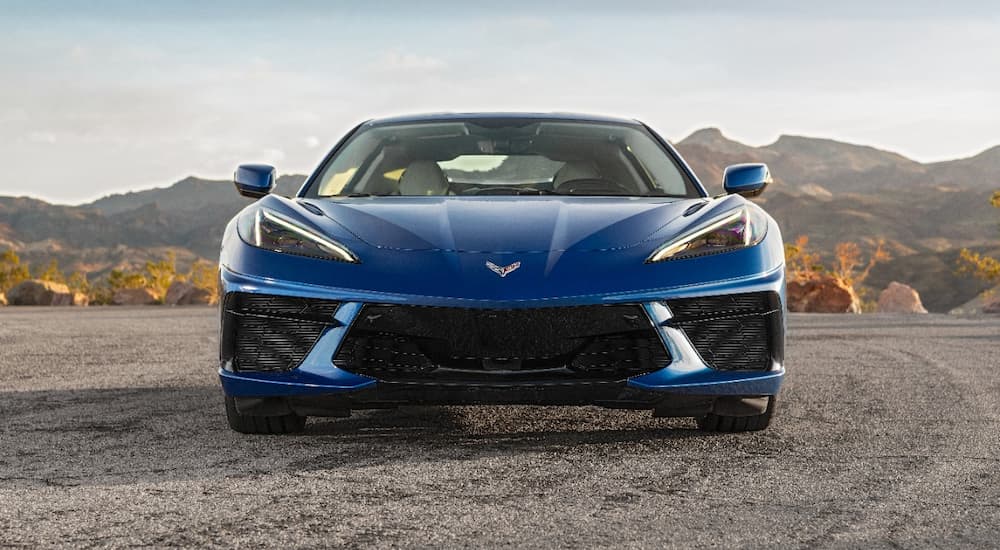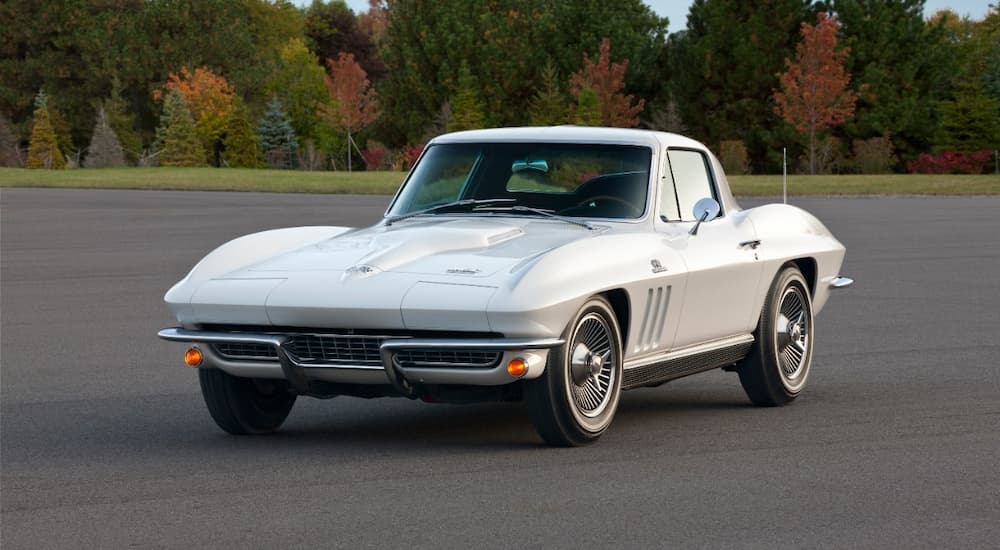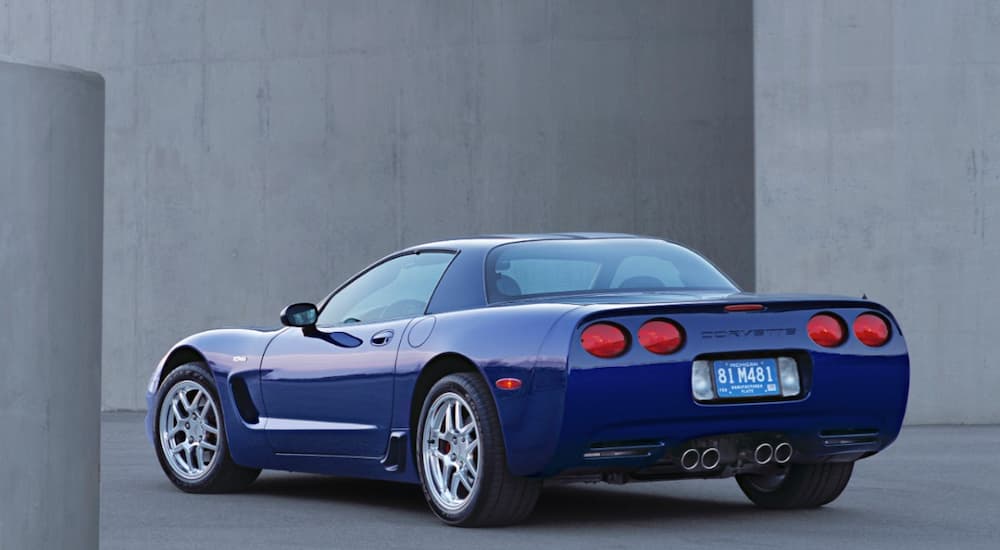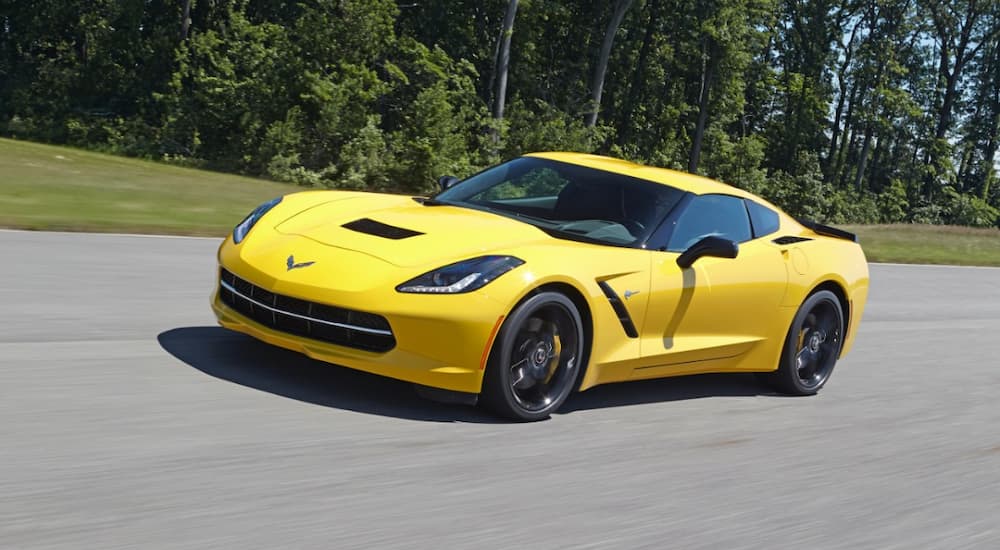
As a used Chevy Dealer in Houston, we’re here to let you in on a really cool secret: there is no other American sports car with the lineage and legacy of the Chevy Corvette. For almost 70 years, Chevrolet has been building these amazing cars, and you can get in on it by buying a used Corvette for yourself. The Chevy Corvette has evolved over eight generations, with the latest version hitting the road in 2020 and pointing to a very bright future. Each successive model has built on the success from the previous one, adding new features, improving upon performance, and featuring head-turning looks that set them apart from other sports cars of their day.
Through each generation of the Corvette, some things have remained consistent. Every model has been rear-wheel drive to boost acceleration, with two doors and two seats. Every Corvette has also featured a front-engine design – that is, until the eighth generation, which became the first model to have a mid-engine design. If you want to get your own part of this great Chevy Corvette legacy, then head over to Parkway Family Chevy. We carry a full lineup of new, used, and certified pre-owned Chevy vehicles, including an extensive inventory of used Corvettes.
The First Generation: Start of a Legacy (1953-1962)
In the early ’50s, Chevrolet decided to start building a sports car designed for performance, returning to the origins of the company formed by Will Durant and racecar driver Louis Chevrolet. The decision was made to use fiberglass for the body in order to get smoother contours while lightening the overall vehicle weight. The first generation of Corvettes were convertibles only and took their name from the small, agile warships that had been used to help win World War 2. The front and rear bumpers were made of shiny chrome to better accent the styling of this sporty roadster.
Chevy initially equipped the Corvette with a 3.9-liter Blue Flame I-6 gas engine that produced 150 horsepower paired with an automatic transmission. Deciding to increase performance, Chevy began offering the Corvette with a 4.3-liter Small Block V8 engine in 1955, discontinuing the Blue Flame I-6 after this model year. An available 3-speed manual transmission was added as well, which would be improved to a 4-speed manual transmission for the 1957 model year.
Those first Corvettes also featured a solid axle rear suspension, something that would be abandoned in future years. In addition, the first-generation Corvette had a trunk, which would also disappear until later generations. The looks would change as well, with the Corvette losing its distinctive tailfins in 1956, also the first year that Chevy would offer an optional hardtop on its flagship coupe.

The Second Generation: Building on Success (1963-1967)
Deciding the times they were a-changing, Chevy made some radical changes to the Corvette for 1963. A hardtop coupe called the Sting Ray joined the convertible model, and it featured a rear split window, something that split opinions among Chevy’s design team. This would be replaced in 1964 with a full window. The designers took advantage of the malleability of fiberglass to give the second generation a tapered rear roofline. The headlights were recessed into the hood and would pop up when engaged.
Also new was an independent rear suspension, giving the Corvette a smoother overall ride. The featured engine on the second generation Corvette was a 5.4-liter Small Block V8 with 360 horsepower, which would be boosted to 375 horsepower for the 1964 model year. Chevy began offering an optional 6.5-liter Big Block V8 with 425 horsepower for the 1965 model year. This would be replaced in 1966 with a 7.0-liter Big Block V8 also with 425 horsepower. The 1966 and 1967 models with the Big Block V8 would sport a distinctive hood bulge.
The Third Generation: The Longest Running Show (1968-1982)
When 1968 rolled around, Chevy decided to redesign the Corvette to capture the styles of the late ’60s with a design based on the Mako Shark concept car. One of the most notable style elements was the introduction of removable roof panels on the t-top roof. This would allow those buying the Stingray coupe to get some of the open-air benefits enjoyed by those driving a Corvette convertible. Also, they changed the name Sting Ray to Stingray. The third generation continued the retractable headlights first introduced in the second generation.
Chevy continued to offer the Corvette with a choice of engines. Where the standard model ran on a 5.7-liter Small Block V8 with 300 horsepower, the more powerful version sported a 7.4-liter Big Block V8 with 360 horsepower. However, Corvettes do not drive in a vacuum, and the increased need for vehicle safety coupled with the rising price of gas led to a number of changes.
First, the engines on the Corvette began to feature smaller output to both operate on low lead and subsequently unleaded gasoline, as well as to provide better fuel economy. As a result, the 5.7-liter Small Block engine went from 300 horsepower and 1968 to 270 horsepower in 1971, and finally only 165 horsepower in 1975. The convertible was also discontinued in 1975 due to lagging sales. In addition, the Big Block engine was discontinued in 1980. Finally, Chevy had to replace the Corvette’s signature chrome bumpers with urethane-covered ones in order to comply with new federal mandates in 1973.
The Fourth Generation: Back to the Future (1984-1996)
1982 marked the last year of the third generation Corvette, and when Chevy failed to release a new model for 1983, some enthusiasts feared this was the end of the road for Chevy’s signature sports car. But those fears were misplaced, and the Corvette came roaring back in 1984 with a full redesign. The fourth generation would prove to be the second-longest run in the storied history of this model, surpassed only by the third generation.
The most distinctive feature of the fourth generation Corvette is its hatchback. This was a nod to the need for at least some cargo space on the two-seater. The t-top roof was replaced by a one-piece Targa top on the Stingray coupe, and lightweight running gear was added to increase performance. However, the car kept the same retractable headlights that first popped up in 1968.
As gas prices began to ease during the Eighties, Chevy began increasing the horsepower on the Corvette. The standard 5.7-liter Crossfire V8 that had 205 horsepower in 1984 was replaced by a 300-horsepower LT engine by the end of the decade. The fourth generation also saw the return of the Corvette convertible in 1986 and the debut of the ZR1 high-performance model in 1990. This successful generation would continue to be built until 1996.

The Fifth Generation: Built for Speed (1997-2004)
Even though the fifth generation of the Corvette lasted only seven years, a great many strides were made in such a short time. First, the redesigned 1997 model sported hydroformed side frame rails made of a single piece of tubular steel. This not only made the car more aerodynamic but also improved its structural integrity. One year later, a hardtop model would join the lineup with permanently fixed roof panels.
1998 was also the year that Corvette brought back the trunk that had been missing since the 1962 model ended the first generation. Another year to note is 2004 – the first year that Chevy used a carbon fiber hood on the front-engine Corvette. This would show a willingness to go with more durable composite materials than the fiberglass that had provided the body for the Corvette since its debut.
The other thing that stands out about the fifth-generation models is that they were very fast. The engines ranged from the 345-horsepower LS1 aluminum Small Block V8 to the 405-horsepower LS6 V8 in the Z06. The latter model gave the fifth generation a top speed of 175 miles per hour, setting a standard for future generations of this sports car.
The Sixth Generation: Bright Eyes (2005-2013)
The first thing you are sure to notice about the sixth generation of the Corvette is that Chevy did away with the retractable headlights that had been a distinctive feature of the car since 1968. The second thing you may notice is that it has a wider stance than previous models, giving the driver and passenger more hip room in the process. But probably the most important change was something that you couldn’t see with the naked eye. Chevy began using a full aluminum frame for the Corvette, reducing gross vehicle weight without sacrificing safety. The exterior was still made of fiberglass, but the aluminum frame supported it without adding too much to the car’s weight. As a result, the sixth-generation model blew past all prior models of the car.
The standard engine on the sixth-generation Corvette is a 6.0-liter V8 with 400 horsepower and 400 lb-ft of torque. Those are numbers that eclipse almost every prior model of the Corvette, and that is just the base engine. The 6.2-liter LS3 V8 was introduced in 2008, producing 430 horsepower and 424 lb-ft of torque, with a top speed of 190 miles per hour. The 7.0-liter LS7 in the Z06 has 505 horsepower and can go 0 to 60 mph in just 3.7 seconds with a top speed of 198 miles per hour. But the absolute champion for speed demons is the 6.2-liter LS9 supercharged V8 on the ZR1 model with 638 horsepower and 604 lb-ft of torque. The sixth-generation Corvette ZR1 has a top speed of 205 miles per hour, making it the fastest Corvette model ever built.

The Seventh Generation: Last of the Front-Engine Models (2014-2019)
The seventh generation of the Corvette was the last to use a front-engine design. This model continued the use of an aluminum frame but used carbon-nano composite for the underbody, as well carbon fiber for the hood and roof panels. The design is sleeker than any prior model, with a more streamlined stance than the sixth-generation model. This is the result of using more composite materials in the design than the prior fiberglass models.
Chevy began offering the Corvette with a choice of a 7-speed manual transmission or a 6-speed automatic with paddle shifters. The latter gives drivers the control associated with a manual transmission without the hassle of working a clutch. This would prove to be a popular feature. Chevy also continued the tradition of offering several engine options on the Corvette.
The standard engine is a 6.2-liter LT1 Small Block V8 with 455 horsepower and 460 lb-ft of torque that can be increased to 460 horsepower and 465 lb-ft with an optional performance exhaust. The Z06 model sports a 6.2-liter LT4 V8 with 650 horsepower and 650 lb-ft torque, while the ZR1 has a 6.2-liter LT5 supercharged V8 capable of 755 horsepower and 715 lb-ft of torque. The seventh generation of the Corvette ZR1 set the mark for quickest acceleration on the model, going from 0 to 60 mph in under 3 seconds. Long gone were the days of the underpowered Corvettes of the ’70s fuel crisis.
The Eighth Generation: To Infinity and Beyond (2020-present)
Chevrolet turned many heads when it announced that its eighth generation of the Corvette would be the first mid-engine model in the car’s history. The current version of the Corvette gives drivers the performance, handling, and looks associated with European supercars at a fraction of the price. Drivers can choose from a coupe or convertible, with each featuring a 6.2-liter LT2 V8 with up to 495 horsepower and 470 lb-ft of torque. While this engine is only slightly more powerful than the standard LT1 Small Block V8 on the seventh-generation Corvette, the mid-engine car more than matches the performance of the prior generation’s top ZR1 model. Paired with an 8-speed dual-clutch transmission with paddle shifters, the eighth generation Corvette can go from 0 to 60 mph in only 2.9 seconds with a top speed of 194 miles per hour. This is the result of the lighter frame, the lower profile, and the rear weight distribution associated with a mid-engine design.
The Future of the Corvette
Chevrolet has built an amazing legacy over the almost 70 years of the Corvette. From a standard convertible with an I-6 engine to a mid-engine supercar, the Corvette has gone through all the phases and innovations associated with a sports car, leading the way in performance and design. As for the future, we may see an electric Corvette in the future, as EV performance continues to improve. Of course, there are those of us who will miss the rumble and roar of a gas engine. We may also see the Corvette add a rear seat, although this will be an even bigger break with tradition than a mid-engine design. However, whichever direction Chevy takes, we are sure to see Corvette leading the way for another 70 years. You can become a part of this legacy by making a used Corvette your next purchase. Whichever generation you choose, you are sure to find that nothing matches the performance and enjoyment of this great sports car.




